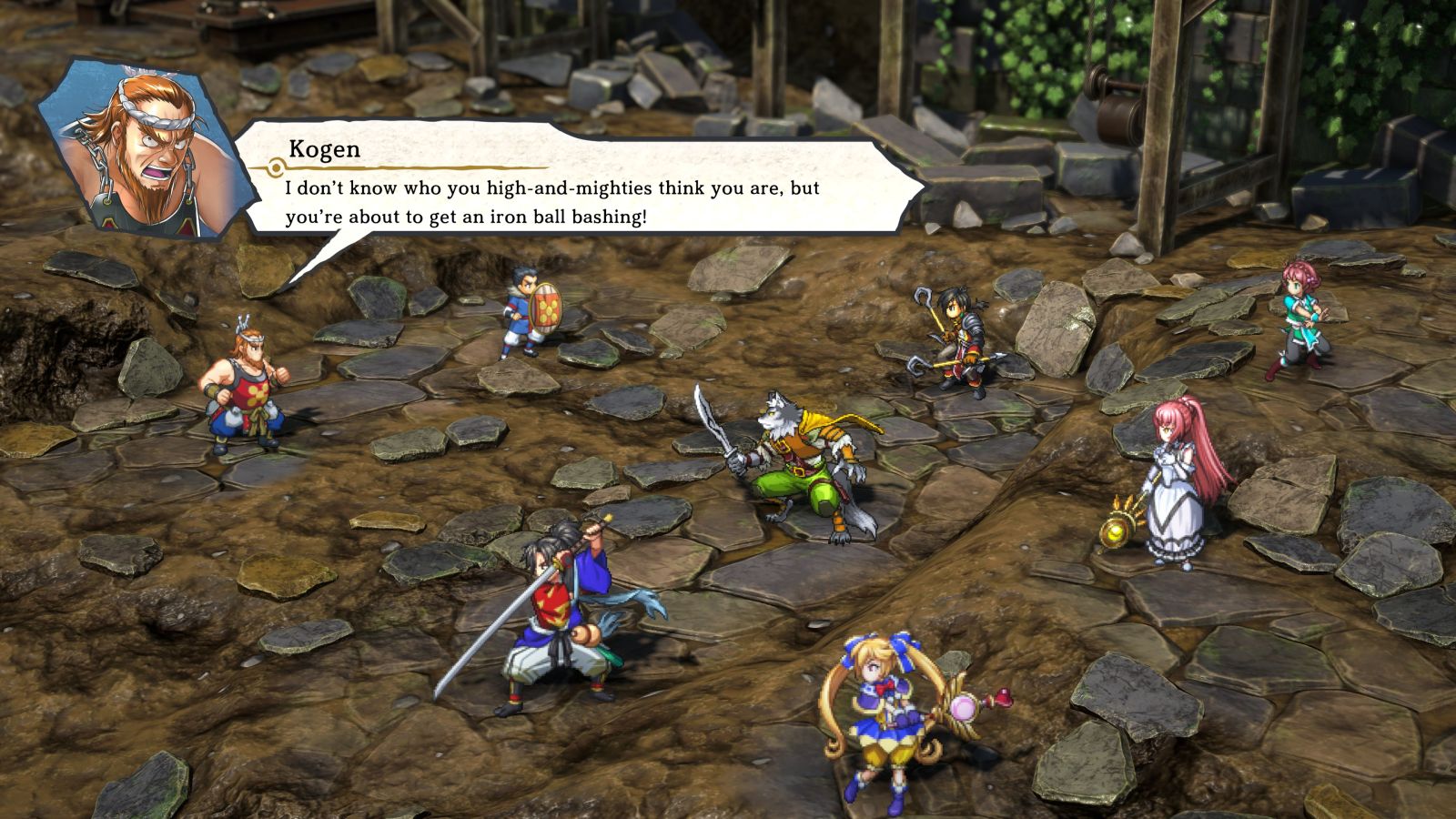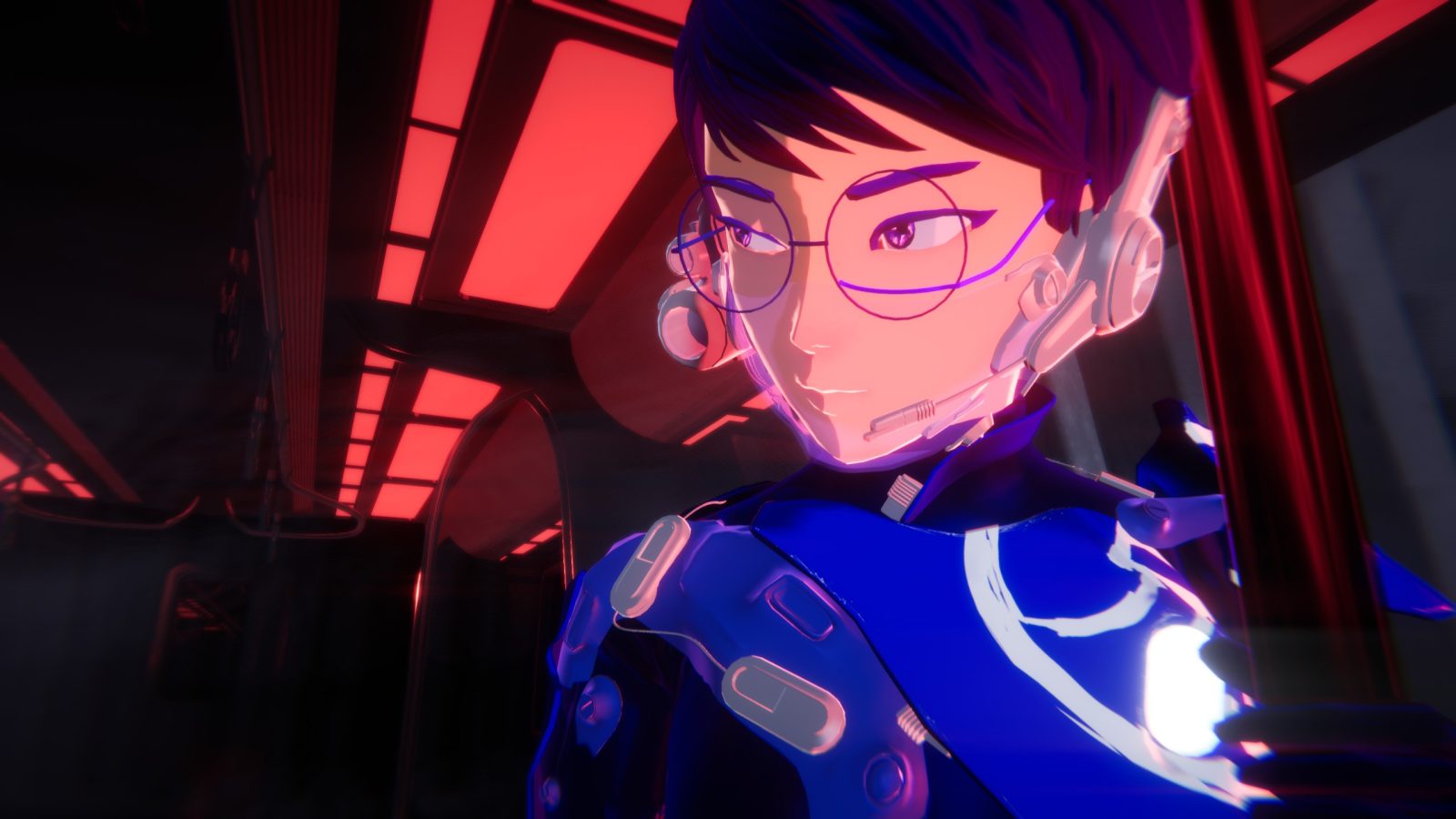Let’s get the first thing out of the way – this game is not Suikoden (which directly translates to Fantasy Water Margin, if you’re curious about the title). That said, there’s so much DNA in common with that incredible series that it’s hard to ignore all the ways it carries the same feel of those games. While Konami has long forgotten Suikoden, it’s very clear that series creator Yoshitaka Murayama (Illustrator / Character Designer – he will be missed!), Junko Kawano (Illustrator / Character Designer), Osamu Komuta (Game Director), and the rest of the team at Rabbit & Bear haven’t forgotten, and neither has its fans. I’m a little late with this review, but given just how expansive Eiyuden Chronicle: Hundred Heroes is, I’d be doing it a great disservice if I didn’t take my time. There’s so much to talk about, so let’s strap in.
Eiyuden Chronicle: Hundred Heroes Pre-launch Trailer (ESRB)
One of the final things that Murayama-san asked of us press members before his passing was that we treat the game with the lightest of touches, allowing returning and new fans alike to experience the wonderful story for themselves. As such, I want to honor those wishes – this will be as spoiler free as I can possibly be.
The story of Eiyuden Chronicle: Hundred Heroes (the name is actually rather redundant when translated – it’s an abbreviation of the original title, Hyaku Eiyuu Densetsu, which translates to Hundred Hero Legend, making this game title “Hundred Hero Legend: Hundred Heroes”) starts with a young and brave warrior named Nowa joining the Watch. Allraan, the continent where this game happens, stands on the precipice of an uneasy alliance between The Galdean Empire, a distant and powerful nation state that has uncovered the ability to amplify rune-lens magic, and the League of Nations. Grum County, where Nowa is from, is a very small part of the League, and is also where the Empire wants to search for a powerful and unique rune-lens to add to their arsenal. Rune-lenses are devices that allow people to cast magic and use various special attacks. Uncovering this rune-lens sets off a chain of events that threaten to tear the nation asunder once more, and Nowa and ultimately 120 of his friends are caught in the middle.
All You Need to Know About Eiyuden Chronicle: Hundred Heroes in 6 Minutes! - Key Features Trailer
If you are getting a “this is classic 90s JRPG” vibe, you are on the right track. This is a traditional “boy becomes the hero that saves the world”, though in this world, you’ll be far from alone. As the name suggests, you’ll be recruiting up to 120 (many are optional, but thankfully none are missable) to help you along the way. Many can help you in combat, and just as many will act as support in a variety of ways – something we’ll talk about at length when we look at base building.
The first thing you’ll likely notice about Eiyuden is the stylized blend of 2D sprites and 3D backgrounds. This pixel art style is fairly novel, but not quite unique. Placed on detailed 3D backgrounds, these 2D sprite characters exhibit a great deal of personality. When joined by an on-screen hand-drawn facial portrait, you get even more immersion as every character is incredibly expressive. The blend of all of these elements screams “classic JRPG” while upgrading it for an entirely new generation. It’s a wonderful way to bridge those two worlds, and it’s one that should hold up nicely into the future.

The art style is not without its technical issues. Even on the most powerful hardware money can buy, there’s a persistent line of sorts where I believe a transition between detail levels is occurring. That means as you run across the land you’ll see this strange line at all times. Similarly, the game uses a tilt-shift style in towns that also employs a Bokeh-like filter to focus your view on the specific subject, such as a shopkeeper. Bugs can cause everything to remain blurry, or otherwise have a jarring effect as it transitions from blurry to sharp. These little odd graphical glitches mostly occur on the 3D overworld, and I feel like I’m seeing a bug in motion. The team has patched four times in less than three weeks, so I feel like they are hard at work on this and other issues.
I am also currently running into an odd bug that comes up infrequently, and never in the same place twice. Occasionally you’ll engage with the enemy, start combat, and the framerate on just that one foe will be sub 15 frames per second. Everyone else is moving full speed, but that one particular baddie is just struggling. Not sure if they need coffee or what, but it’s odd. I know the team is working on fixing an issue with encounter rates and high refresh rate monitors (something that is still happening post-fix), but I’m not sure if this is related. Either way, it’s a visual bug that can occasionally turn into one that, if left long enough, slows inputs. You’ll press up or down on the D-Pad, and then a few seconds later it’ll activate the button press. Once the foe is dead, everything returns to normal. I wish the Rabbit & Bear team the best in trying to resolve that one – it feels like a tough one to isolate, much less fix. The point with all of this is that there are a handful of bugs yet to be hammered out.

Then there is the elephant in the room: the loading screens. They are somewhat frequent, but thankfully very, very short. It can be as short as a single second, but it doesn’t seem necessary, other than an engine limitation with Unity. I’ve got the game loaded onto a PCIe 5.0 NVMe so there’s no reason this can’t be overcome with hardware. Here’s hoping future patches and rabid fans can reduce or fix this.
The voice acting and localization is solid in Eiyuden Chronicle. Nowa (voice by Andrew Wheildon-Dennis) does a fantastic job of growing from wide-eyed rookie to confident leader. Seign, a lieutenant from the Empire (Voiced by Will de Renzy Martin) is calm and collected, and comes across as a young and idealistic officer who has his eyes opened to a world beyond what he was trained to understand. Garr (Voiced by Erik Garr) is the gruff seasoned veteran, a little bit jaded, but ever-reliable for the team. Lian (Voiced by Anjali Kunapaneni) is the prankster of the team, but her Monk skills are unrivaled in combat. Frankly, I could go on for 100+ heroes and not hit one that got a bad voiceover, though you do have to accept that you’ll be dealing with squeaky voiced children on the team. It’s just a JRPG fact of life. The only place the voiceover falls down is in combat. Voice repetition is fairly rampant, as is the scene ending and clipping off the end of a voiceover.

While we are on the topic of audio, the music from Motoi Sakuraba (Veteran of the Tales series, Shining Force 3, Golden Sun, and Baten Kaitos) and Michiko Naruke (He brought us Wild ARMs 1-4), is fantastic. It’s whimsical, inspirational, fun, sad, and filled with tension when the need arises. It does a great job of helping the player stay in the moment, and it’s worth the extra bucks to pick up the Deluxe Edition for the soundtrack.
I’d be remiss if I didn’t mention how wide a net Rabbit & Bear cast with respect to the various heroes you’ll encounter. Sure, there are plenty of humanoid characters, but a great many are not. For example, Garr is a lycanthrope. Lilwn Rowad Fawud is a forest elf. Euphelius VII is a shark that stands on two legs, wears people clothes, and talks. There’s a race of kangaroos. And yes, dear reader, there are even racoons. There are so many more types of friends to discover (including one simply called “Friend”), but part of the allure of Eiyuden is finding them for yourselves. It’d be a crying shame if I ruined any of that for you.

Just like in the Suikoden series, when you find an ally that can synergize an attack with another, that attack will appear on the menu. These attacks are often significantly more powerful than a standard attack, or unleash special powers or effects that can turn the tide. You’ll have to play around with your party makeup to discover these, as they aren’t necessarily obvious otherwise. These are fun to discover, though the animations can be overlong and unskippable.
Combat is a bit expanded over what you’d normally see in a JRPG. Instead of the typically four stack, you’ll be bringing six companions to the field – three in the front, and three in the rear. Beyond this, you’ll also have up to three “Attendant” roles. These slots are for companions you want to bring into the field, but not necessarily into combat. While they don’t gain XP, they do augment the experience. Bringing in someone who runs an Inn, for instance, will allow you some of the Inn functionality (e.g. changing your party and assigning runes) when at a simple save spot. This can be handy for changes on the fly. Similarly, bringing a lumberjack means picking up additional lumber when you gather at those nodes. Even the main hero, Nowa, can be put in the attendant spot, ensuring he can participate in the story without necessarily being on the front lines.

As your character levels up, they’ll periodically unlock additional rune slots. These allow you to bring multiple skills, spells, or abilities to the fight, which also allows you to bend a character’s normal class a bit. I have one “healer” that hits almost as hard as a fighter when she needs to. Heading to a specialty vendor, you can swap your runes around, granting you access to new powers and attacks. These are powered by “SP”, which builds up with every attack. Each rune or team-up takes a certain amount from one or both of your SP pools, so it’s another resource to juggle in the combat / magic / powers triangle. Some runes are bound to specific characters, but as you discover more, you’ll be able to move them around to maximize their effectiveness.
As is tradition in any good JRPG, you’ll eventually run up against a boss. These are rarely standard fights, with foes often being far, far larger than anything else you’ve encountered. In typical fashion, they also have strengths, weaknesses, and other special attacks that can cause you all sorts of grief. What’s different here is that each has a “gimmick” – it’s even labeled with that word! I don’t want to spoil anything, so I’ll just tell you about the first one you encounter. The foe will strike in a straight line, hitting anyone in that path, so your gimmick is to skip your attack and instead hide behind some nearby rocks. These gimmicks aren’t complex in the beginning, and there are a few that rely on dumb luck, but they do give enough flavor to shake things up nicely. You’ll even occasionally run into gimmicks in the field, cracking open a treasure chest mid-combat, for example.

In addition to normal combat, you’ll also occasionally take to a larger battlefield with War Mode. War Mode takes you to a semi-isometric / top down where you and your army will clash on the battlefield. These are massive fights with your heroes and their support units where flanking, tactics, your hero powers, and your choices are put to the test. These start off relatively simple, but soon you’ll have to put in some real work to win here. It’s far more than a tacked-on fight mode, but I do have to admit that these are very, very slow. You’ll unleash special powers and use tactics unique to each character, but these fights feel like they take forever.
Like you’d find in a Suikoden title, eventually you’ll shift gears from survival to making an honest pushback, and that means building a base of operations. Taking over an abandoned fortress, you’ll find no shortage of work to be done. Unfortunately, you don’t have the expertise to do it, but that’s nothing that recruiting can’t fix. Your fallow fields can be brought to life by finding somebody with a green thumb. The produce from those fields can be turned into real food, if you can find a cook with the skills. Fixing your armory, you’ll gain access to armor for purchase. Fixing your lumberyard can start to generate lumber (what else did you expect?) that you can then sell for baqua (the money in the game) to put back into the venture. Establishing trade routes, gathering resources like herbs and hunting, and selling goods all serve to build up your town’s capabilities. Not every one of your hundred heroes are battle tested, but at the end of the day, all of them need a please to be safe, eat, and rest their head. Once you’ve built your fortress enough, you’ll also unlock a number of fun minigames. Cooking competitions (I can out-cook a giant griffin!), racing, a complex card game, fishing, and more. Watching this fortress slowly transform from crumbling detritus to a powerful symbol of the resistance was one of my favorite parts of the game, and every evolution made it feel like home.

There is a challenge with Eiyuden that’s pervasive across the board – balance. Team combat, the War mode, random encounters, boss fights – all of them can be wildly unbalanced at times, and much of that has to do with team dynamics. Some characters are wildly underpowered no matter how many times you upgrade their weapons and provide stat-boosting runes. Others breeze through the game like it’s a walk in the park. Doing several balance passes across 120 characters, plus every boss, and every random encounter, must be an incredibly daunting task, and that’s where post-launch balancing will be important as we the public test the game further than the Rabbit & Bear team could ever have done on their own. The hope is that this will improve over time.
To help with some of the grind of the game, there’s an auto-combat system. You can use menus to set conditions like “Attack the lowest hitpoint creature” or “automatically cure me if I’m poisoned” or “heal me if I drop below 50% HP”. Further adjustments to prioritize targets, favor melee vs. magic, and other tweaks can really make it easy to whip through foes quickly. It’s a great quality of life addition that I was happy to see. You won’t need to be anywhere near the level cap of 99 to beat the game (around half or slightly less), but if you are a completionist, there are tools here to help.

Ultimately Eiyuden Chronicle: Hundred Heroes scratches the classic JRPG itch, and represents a great start for Rabbit & Bear as its own studio. They’ve announced that they are already pressing forward on sequel planning, and the hope is that the lessons learned here will only make the next one better. It may not have the polish of some of their previous efforts, but it does give us exactly what we asked for – a spiritual successor that leaves us wanting more.
Ron Burke is the Editor in Chief for Gaming Trend. Currently living in Fort Worth, Texas, Ron is an old-school gamer who enjoys CRPGs, action/adventure, platformers, music games, and has recently gotten into tabletop gaming.
Ron is also a fourth degree black belt, with a Master's rank in Matsumura Seito Shōrin-ryū, Moo Duk Kwan Tang Soo Do, Universal Tang Soo Do Alliance, and International Tang Soo Do Federation. He also holds ranks in several other styles in his search to be a well-rounded fighter.
Ron has been married to Gaming Trend Editor, Laura Burke, for 28 years. They have three dogs - Pazuzu (Irish Terrier), Atë, and Calliope (both Australian Kelpie/Pit Bull mixes), and an Axolotl named Dagon!

While not every gambit succeeds, Eiyuden Chronicle: Hundred Heroes delivers us the spiritual successor we all dared to hope for, but never expected to get. While things like the War Mode and some balance issues and bugs will require additional attention, there’s a great JRPG here worth playing.
PROS
- Base building is a fun and engaging
- Combat combos are fun to discover and use
- Rune system provides flexibility
- 120 characters to mix and match
- Artistic blend of 3D and 2D
CONS
- War Mode is painfully slow
- Balance issues remain
- Plenty of bugs
Unless otherwise stated, the product in this article was provided for review purposes.
See below for our list of partners and affiliates:

 2 weeks ago
50
2 weeks ago
50








